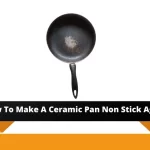Common Misconceptions About Cleaning the Cast Iron Skillet
Table of Contents,
Why is proper cleaning necessary for maintaining cast iron seasoning?
Proper cleaning is vital for maintaining the seasoning of cast-iron cookware. Seasoning refers to the layer of polymerized oil or fat that forms on the pan’s surface through heating and oil application. This layer provides a naturally non-stick surface, protects the iron from rusting, and enhances the food’s flavors. Failing to clean cast iron correctly can lead to the deterioration of the seasoning, resulting in a loss of its desirable properties.If you want your beloved cast iron cookware to last for ages and keep performing like a champ, it’s high time you grasp the perks it brings, smash those silly myths floating around, and seriously consider proper scrubbing. Buckle up because we’ll dive into the ultimate secrets and tricks for giving your cast iron a sparkling clean after a mouthwatering cooking session.Cleaning Rules of Skillets:
It is fruitful to follow these rules for the basic cleaning of cast iron after cooking:Avoid using soap while cleaning the cast-iron pan:
Soap should be strictly avoided as it can disrupt the cast iron’s seasoning. Use the cleaning methods in the section Step-by-Step Guide to remove food residues.Steer clear of wire brushes or steel wool scouring pads:
Abrasive tools like wire brushes or steel wool can scratch the surface of the cast iron, potentially damaging the seasoning. Opt for non-abrasive brushes or sponges for gentle cleaning.Minimise water usage:
Use as little water as possible for cleaning cast iron. Excessive water can lead to prolonged contact, increasing the risk of Corrosion formation. Employ a minimal amount of water to rinse the pan thoroughly.Avoid dishwashers:Never place your cast iron cookware in an electric dishwasher. The harsh detergents and high heat can strip away the seasoning and cause damage to the pan. Hand washing is the preferred method for cleaning your Skillet.Pouring cool water in the hot pan:
After cooking, refrain from pouring cold water directly into the hot pan. The drastic temperature change can cause the pan to warp or crack. After naturally cooling down the pan, rinse it with tap water for cleaning.By adhering to these cleaning rules, you can effectively maintain the integrity and seasoning of your nonstick cookware. Remember, proper cleaning is essential for the longevity and optimal performance of your beloved cast iron skillets.Required Accessories for Cast Iron Pan Cleaning After Cooking:
Make sure to have the following accessories on hand for cleaning the panNon-abrasive brush or sponge:
Use a non-abrasive brush or sponge specifically designed for cleaning cast-iron cookware. This will ensure the gentle yet effective removal of food residues without causing any damage to the pan’s surface.Hot water for cleaning the Pan surface :
Prepare hot water to aid in loosening and removing stubborn food particles. The heat helps to loosen the residues, making them easier to clean without excessive scrubbing.Step-by-Step Guide to Clean Cast Iron Using These Accessories:
Allow the pan to cool:
After you finish cooking, allow the Skillet to cool completely. This will help prevent any potential risk of flaming smoke and burning of the pan surface.Rinse with hot water:
Place the Skillet under hot running water. The hot water will help to loosen the food residues and make them easier to remove. Use a non-abrasive Scrubber or sponge to gently scrub the pan, ensuring you reach all areas, including the corners and sides.Stubborn residue (optional):
If stubborn food particles resist removal with water alone, you can add a small amount of mild dish soap to the brush or sponge. Gently wash the affected areas to remove the remaining residues. Thoroughly rinse with water to remove any soap residue.Dry the Skillet:
After cleaning the pan, dry the cast iron pan with a clean towel. Ensure it is completely dry to prevent moisture and rust formation.Season the pan (if necessary):
If you notice any seasoning loss or want to reinforce it, apply a thin layer of cooking oil to the pan’s interior. Use a paper towel to spread the oil evenly. This step helps to maintain the non-stick surface and protect the Surface.These steps help you effectively clean your Pan’s Surface after cooking, ensuring its longevity and optimal performance for many future meals.Additional techniques for removing minor rust from a cast iron pan:
Using these techniques, you can remove minor rust from your cast iron pan and restore its functionality and appearance.Sandpaper (medium to fine grit)
- Gently sand the rusty area using sandpaper, applying moderate pressure. Move the sandpaper in circular motions to remove the Corrosion effectively.
- Continue sanding until the Residue is eliminated and the surface appears smooth.
Use of Raw Potato in cleaning cast iron cookware
- Cut a raw potato in half.
- Using the cut side of the potato, rub the rusted area of the cast iron pan vigorously.
- The oxalic acid naturally present in the potato will help break down the rust.
- Continue scrubbing until the rust is removed from the pan.
Steel Wool Scrubber:
- Take a piece of steel wool and dampen it with water.
- Gently scrub the rusty area of the cast iron pan using the steel wool.
- Apply light to moderate pressure while scrubbing to remove the rust.
- Rinse the pan thoroughly after scrubbing to remove any loosened rust particles.
Rust Remover:
- Choose a rust remover product that is safe to use on cast iron. Follow the instructions provided on the product packaging for best results.
- Apply the rust remover to the rusty area of the cast iron pan.
- Allow the product to sit for the recommended duration.
- Use a brush or sponge to scrub the rusted area.
- Rinse the pan thoroughly with water after removing the rust.
Rust removal with Electrolysis:
- Set up an electrolysis system by connecting a power source, an anode (usually made of sacrificial metal like steel), a container filled with water and an electrolyte (such as baking soda), and appropriate wiring connections.
- Submerge the rusty cast iron pan as the cathode in the water bath.
- Allow the electrolysis process to run for a specific duration (according to the rust severity).
- Once completed, remove the pan, scrub off any remaining rust, and thoroughly rinse and dry it.
Usage of Vinegar for cast iron skillet:
- Create a solution by mixing equal parts of water and vinegar.
- Submerge the rusty area of the cast iron pan in the vinegar solution and let it soak for several hours or overnight.
- Scrub the rusted area with a non-abrasive brush or sponge after soaking.
- Rinse the pan thoroughly with water to remove any vinegar residue. 5. Dry the pan completely to prevent new rust formation.
Utensils required to clean a cast-iron skillet:
It does not matter what utensils you use to remove stubborn chunks of food that seem permanently attached to your pan’s surface. Wooden and Teflon-coated utensils are ideal for dusting off the wire whisk and gently loosening the stuck-on food. You can carefully remove stubborn food residues from the pan’s surface using a putty knife as well. The thin and flat edge of the putty knife allows for precise scraping without causing damage to the pan. These utensils help you effectively remove tough residues from your pan and restore its clean and smooth surface. It is necessary to use these utensils gently and carefully.Common Mistakes to Avoid:
Cleaning cast iron cookware requires special care to maintain its quality and longevity. Here are some common mistakes to avoid:Use of abrasive cleaners:
Scrubbing cast iron with harsh cleaners or abrasive pads can damage the seasoning and scratch the surface. You can use specially designed non-abrasive brushes or sponges for cleaning the iron pan.Soaking cast iron for prolonged periods:
Allowing cast iron to soak in water for an extended period can lead to rust formation. Opt for a shorter cleaning process using hot water and gentle scrubbing.Forget to dry the cookware:
After cleaning, it’s crucial to dry the cast iron thoroughly. Any moisture left on the surface can lead to rust. Towel-dry the pan and place it on the stovetop or in a warm oven for a few minutes to ensure complete drying.Storing cast iron without proper seasoning:
Seasoning cast iron creates a protective layer that prevents rust and enhances its non-stick properties. After cleaning, apply a thin layer of oil to the pan’s surface. This helps maintain its seasoning and prevents moisture from causing rust.Proper cleaning and maintenance techniques allow you to keep your cast iron cookware in excellent condition for years.ALSO, READ
FAQs
Rust is the enemy of cast iron, but you can take steps to prevent it. After cleaning, ensure your cast iron is completely dry to prevent moisture from causing rust. You can also apply a thin cooking oil or shortening layer to the pan’s surface before storing it. This helps create a barrier against moisture and oxidation.
After cleaning, thoroughly dry your cast iron skillet with a clean cloth or paper towel. Place it on the stove over low heat for a few minutes to evaporate any remaining moisture. This step helps prevent the pan from developing rust.
To maintain the seasoning, after each use, wipe the skillet with a thin layer of oil while it’s still warm. This helps to replenish the protective coating and prevent rust. Regularly seasoning your pan will keep it in great condition for years.
No, it’s not recommended to clean cast iron in a dishwasher. The harsh detergents and high temperatures can strip away the seasoning and potentially cause rust. It’s best to hand wash your cast iron pan using mild dish soap and warm water.
If you have stubborn food stuck on your cast iron pan, fill it with water and bring it to a gentle boil on the stove. Allow the water to simmer for a few minutes, then use a wooden spatula or scraper to loosen the food particles. Once the stuck-on food is loosened, follow the regular cleaning process with hot water and mild dish soap.







